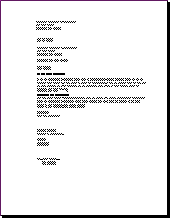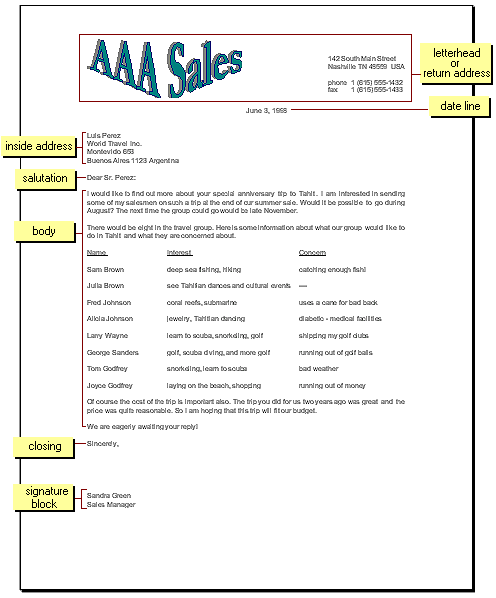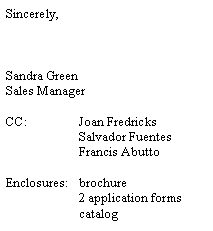Jan's Working with Words
Templates: Letters
A business letter has a standard format. Let's review the parts of a standard business letter.
Business Letter Formats
 |
 |
 |
| Left aligned paragraphs | Indented paragraphs | Left aligned on letterhead paper |
Parts of a Letter
The illustration below labels the sections of a letter. There are several acceptable variations in placement on the page for these sections, as the examples above illustrate. Most businesses now left align all the paragraphs and add extra white space between paragraphs instead of indenting the first line of a paragraph. It's simple; it's easy to learn; it communicates well.

Letterhead paper: A standardized page that includes such information as the company's name, the company logo, the address, phone numbers, email address, and web site address.
Letterhead paper looks more professional than plain paper. Many letterheads also include the names of important people in the company or department. These often are listed down the side of the page or across the bottom, not exactly the "head" of the letter. It's still it's called a letterhead, even when parts are at the bottom of the page!
In the days of typewriters, letterhead paper had to be pre-printed by a printing company and you typed your letter directly on it. Today you can create your own letterhead design and save it on your computer. Then each time you write a letter, you start with the letterhead document. It's all printed at the same time.
You can still use pre-printed paper for letters. You can also buy holiday paper with snowflakes or dancing reindeer, party invitation paper with cakes and candles and balloons on it, and even wedding invitation paper with roses and ribbons, and a wedding cake already printed on the paper. When you use paper with pre-printed borders or graphics, you must measure very carefully and change the margins of your document in your word processor so that your text will not print on top of the pre-printed parts.
 Signature block: the items
below your actual signature.
Signature block: the items
below your actual signature.
You always type your name here. Most of us don't sign our names too clearly, so this is important!
You could include your title (if you have one!) and the company name if you are not using letterhead paper.
You can include lines like the following when they fit the situation:
CC: If you are sending a copy of this letter to others, list their names below your signature. CC originally meant "carbon copy" when carbon paper was used to create additional copies with a typewriter. The newer term is "courtesy copy".
Enclosures: If you are enclosing other documents, tell how many there are or list the documents.
Attachments: If your letter is part of a set of documents that belong together, list the documents that are "attached" to your letter. For example a construction contract could have pages of approved changes attached to the original contract.
